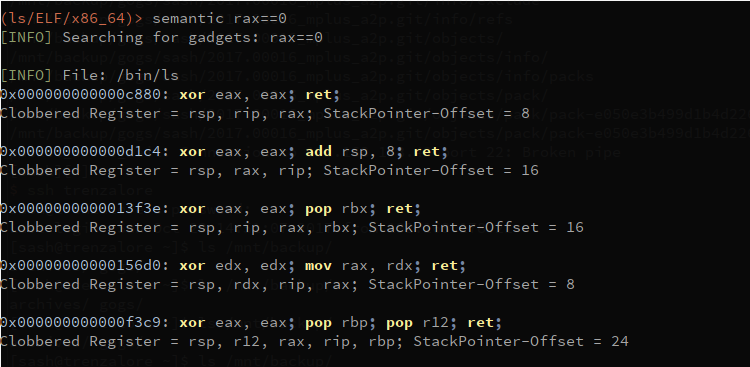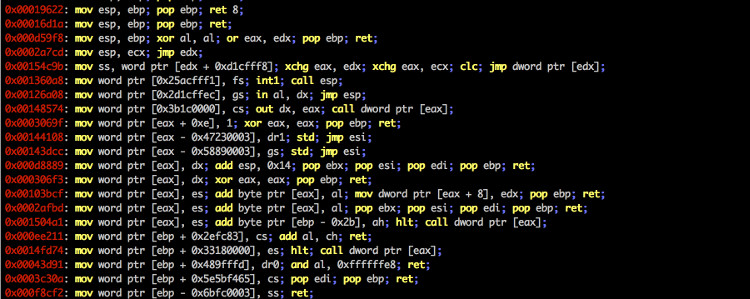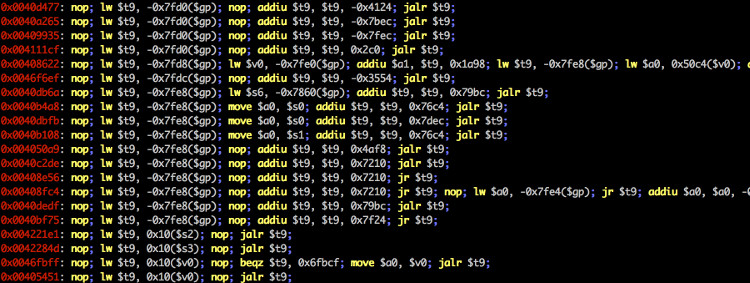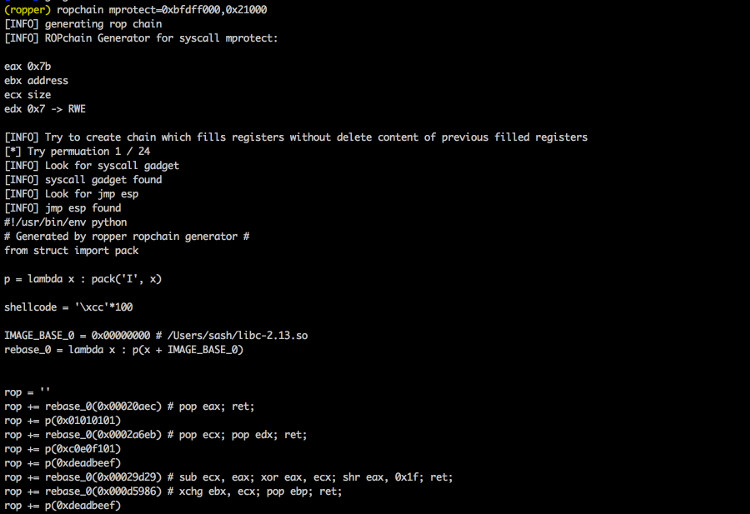 Ropper
Ropper
Display information about files in different file formats and find gadgets to build rop chains for different architectures (x86/x86_64, ARM/ARM64, MIPS, PowerPC, SPARC64). For disassembly ropper uses the awesome Capstone Framework.
Top Related Projects
PEDA - Python Exploit Development Assistance for GDB
GEF (GDB Enhanced Features) - a modern experience for GDB with advanced debugging capabilities for exploit devs & reverse engineers on Linux
Exploit Development and Reverse Engineering with GDB & LLDB Made Easy
This tool lets you search your gadgets on your binaries to facilitate your ROP exploitation. ROPgadget supports ELF, PE and Mach-O format on x86, x64, ARM, ARM64, PowerPC, SPARC, MIPS, RISC-V 64, and RISC-V Compressed architectures.
CTF framework and exploit development library
Quick Overview
Ropper is an open-source tool for searching and analyzing binary files for gadgets that can be used in Return-Oriented Programming (ROP) exploits. It supports multiple architectures and file formats, making it a versatile tool for security researchers and exploit developers.
Pros
- Multi-architecture support (x86, x86_64, ARM, MIPS, PowerPC)
- Supports various file formats (ELF, PE, Mach-O, raw binary)
- Provides a command-line interface and a Python API for scripting
- Offers advanced features like semantic search and automatic ROP chain generation
Cons
- Steep learning curve for beginners in exploit development
- Limited documentation for some advanced features
- May produce a large number of gadgets, requiring manual filtering
- Performance can be slow when analyzing large binaries
Code Examples
- Basic gadget search:
from ropper import RopperService
rs = RopperService()
rs.addFile('target_binary')
rs.loadGadgets()
gadgets = rs.searchGadgets('pop rdi')
for gadget in gadgets:
print(gadget)
- Generating ROP chain:
from ropper import RopperService
rs = RopperService()
rs.addFile('target_binary')
rs.loadGadgets()
chain = rs.createRopChain('execve', {'cmd':'/bin/sh'})
print(chain)
- Semantic gadget search:
from ropper import RopperService
rs = RopperService()
rs.addFile('target_binary')
rs.loadGadgets()
semantic_gadgets = rs.searchSemanticGadgets('mov [rdi], rsi')
for gadget in semantic_gadgets:
print(gadget)
Getting Started
- Install Ropper:
pip install ropper
- Basic usage:
ropper -f target_binary
- Search for specific gadgets:
ropper -f target_binary --search "pop rdi"
- Generate ROP chain:
ropper -f target_binary --chain "execve cmd=/bin/sh"
For more advanced usage, refer to the project's documentation and explore the Python API for custom scripting and integration into your security tools.
Competitor Comparisons
PEDA - Python Exploit Development Assistance for GDB
Pros of PEDA
- Integrated with GDB, providing enhanced debugging capabilities
- Offers colorized and customizable output for better readability
- Includes built-in commands for common exploit development tasks
Cons of PEDA
- Limited to x86 and x86-64 architectures
- Requires GDB, which may not be available in all environments
- Less focused on ROP chain generation compared to Ropper
Code Comparison
PEDA command example:
gdb-peda$ pattern create 200
'AAA%AAsAABAA$AAnAACAA-AA(AADAA;AA)AAEAAaAA0AAFAAbAA1AAGAAcAA2AAHAAdAA3AAIAAeAA4AAJAAfAA5AAKAAgAA6AALAAhAA7AAMAAiAA8AANAAjAA9AAOAAkAAPAAlAAQAAmAARAAoAASAApAATAAqAAUAArAAVAAtAAWAAuAAXAAvAAYAAwAAZAAxAAyA'
Ropper command example:
$ ropper --file /bin/ls --search "pop rdi"
[INFO] Load gadgets from cache
[LOAD] loading... 100%
[LOAD] removing double gadgets... 100%
[INFO] Searching for gadgets: pop rdi
[INFO] File: /bin/ls
0x00000000004018f3: pop rdi; ret;
GEF (GDB Enhanced Features) - a modern experience for GDB with advanced debugging capabilities for exploit devs & reverse engineers on Linux
Pros of GEF
- Integrated debugging environment within GDB, offering a more comprehensive toolset
- Extensive features for exploit development and reverse engineering
- Active community and regular updates
Cons of GEF
- Steeper learning curve due to its extensive feature set
- Requires GDB, which may not be available on all platforms
Code Comparison
GEF example:
gef➤ pattern create 100
[+] Generating a pattern of 100 bytes
aaaabaaacaaadaaaeaaafaaagaaahaaaiaaajaaakaaalaaamaaanaaaoaaapaaaqaaaraaasaaataaauaaavaaawaaaxaaayaaa
Ropper example:
(ropper)> search /x90/
[INFO] Searching for gadgets: /x90/
0x080484b6: nop; ret;
0x080484b7: nop; leave; ret;
Key Differences
- GEF is a GDB extension, while Ropper is a standalone tool
- Ropper focuses on ROP gadget searching and generation, whereas GEF provides a broader set of debugging and exploitation tools
- GEF offers a more interactive debugging experience, while Ropper is primarily used for offline analysis
Exploit Development and Reverse Engineering with GDB & LLDB Made Easy
Pros of pwndbg
- Integrates directly with GDB, providing enhanced debugging capabilities
- Offers a rich set of commands for memory analysis and exploit development
- Provides colorized and user-friendly output for easier debugging
Cons of pwndbg
- Requires GDB and may have a steeper learning curve for beginners
- Limited to debugging scenarios, not focused on ROP chain generation
Code Comparison
pwndbg:
from pwndbg.commands import Command
from pwndbg.commands import cmdrepeat
@Command
@cmdrepeat
def stack(count=8):
"""
Print out the stack
"""
print(pwndbg.commands.hexdump.hexdump(pwndbg.regs.sp, count*pwndbg.arch.ptrsize))
Ropper:
def createRopChain(self, gadgets, filename, rope):
writer = RopChainX86_64(self, gadgets, filename, rope)
return writer.create()
Summary
pwndbg is a GDB plugin that enhances debugging capabilities for exploit development and reverse engineering. It offers a wide range of features for memory analysis and provides a user-friendly interface within GDB.
Ropper, on the other hand, is primarily focused on finding gadgets and creating ROP chains. It's a standalone tool that can be used independently of a debugger.
While pwndbg excels in debugging scenarios, Ropper is more specialized for ROP chain generation and gadget discovery. The choice between the two depends on the specific needs of the user and the task at hand.
This tool lets you search your gadgets on your binaries to facilitate your ROP exploitation. ROPgadget supports ELF, PE and Mach-O format on x86, x64, ARM, ARM64, PowerPC, SPARC, MIPS, RISC-V 64, and RISC-V Compressed architectures.
Pros of ROPgadget
- Simpler and more straightforward to use
- Faster execution for basic gadget searching
- Better integration with other security tools
Cons of ROPgadget
- Less comprehensive feature set
- Limited support for advanced ROP chain generation
- Fewer options for customizing search parameters
Code Comparison
ROPgadget:
from ROPGadget.args import Args
from ROPGadget.core import Core
args = Args().getArgs()
Core(args).analyze()
Ropper:
from ropper import RopperService
rs = RopperService()
rs.addFile('binary')
rs.loadGadgets()
gadgets = rs.search(search='pop rdi')
Both tools provide Python APIs for integration into other projects. ROPgadget's API is simpler and more direct, while Ropper offers a more comprehensive set of options and methods for advanced usage.
Ropper generally provides more flexibility and features for complex ROP chain creation, while ROPgadget excels in quick and straightforward gadget discovery. The choice between the two often depends on the specific requirements of the project and the user's familiarity with ROP techniques.
CTF framework and exploit development library
Pros of pwntools
- Comprehensive toolkit for CTFs and exploit development
- Extensive documentation and active community support
- Seamless integration with other security tools and frameworks
Cons of pwntools
- Steeper learning curve for beginners
- Larger codebase and dependencies, potentially slower for simple tasks
Code Comparison
pwntools:
from pwn import *
r = remote('example.com', 1337)
r.sendline(b'Hello, World!')
response = r.recvline()
log.info(f'Received: {response.decode()}')
Ropper:
from ropper import RopperService
rs = RopperService()
rs.addFile('binary')
gadgets = rs.searchGadgets('pop rdi')
for gadget in gadgets:
print(gadget)
Key Differences
- pwntools is a full-featured exploitation framework, while Ropper focuses on ROP gadget discovery
- pwntools offers more comprehensive networking and binary manipulation capabilities
- Ropper provides more specialized tools for ROP chain creation and analysis
Use Cases
- pwntools: CTF competitions, exploit development, and general-purpose security scripting
- Ropper: Focused ROP gadget analysis, binary exploitation research, and targeted exploit crafting
Convert  designs to code with AI
designs to code with AI

Introducing Visual Copilot: A new AI model to turn Figma designs to high quality code using your components.
Try Visual CopilotREADME
Ropper
You can use ropper to display information about binary files in different file formats and you can search for gadgets to build rop chains for different architectures (x86/X86_64, ARM/ARM64, MIPS/MIPS64, PowerPC/PowerPC64, SPARC64). For disassembly ropper uses the awesome Capstone Framework.
Install
Install Capstone with PyPi:
$ sudo pip install capstone
Install filebytes with PyPi:
$ sudo pip install filebytes
Optional (not needed to run ropper just to look for gadgets):
Install Keystone:
$ sudo pip install keystone-engine
Install and execute Ropper
$ python setup.py install
$ ropper
You can also install Ropper with pip
$ pip install ropper
If you want, you can use Ropper without installation
$ ./Ropper.py
If you don't want to install filebytes, filebytes is a submodule of the ropper repository. This means you don't need to install filebytes and ropper.
$ git clone https://github.com/sashs/ropper.git
$ cd ropper
$ git submodule init
$ git submodule update
$ ./Ropper.py
THIS FEATURE IS STILL UNDER DEVELOPEMENT! Ropper has a semantic search command, which offers the possiblity to search for gadgets.
$ ropper --file <afile> --semantic "<any constraint>"
The following optional dependencies are needed to use semantic search:
Install pyvex
$ sudo pip install pyvex
Install z3py
$ python scripts/mk_make.py
$ cd build
$ make
$ sudo make install
Currently Possible Constraints
reg == reg - assign register to another
reg == number - assign number to register
reg == [reg] - assign memory to register
reg += number/reg/[reg]
reg -= number/reg/[reg]
reg *= number/reg/[reg]
reg /= number/reg/[reg]
Constraint Example
eax==1 !ebx - set eax to 1 and look for gadgets which does not clobber ebx

Usage
usage: Ropper.py [-h] [--help-examples] [-v] [--console]
[-f <file> [<file> ...]] [-r] [-a <arch>]
[--section <section>] [--string [<string>]] [--hex]
[--asm [<asm> [H|S|R] ...]] [--disasm <opcode>]
[--disassemble-address <address:length>] [-i] [-e]
[--imagebase] [-c] [-s] [-S] [--imports] [--symbols]
[--set <option>] [--unset <option>] [-I <imagebase>] [-p]
[-j <reg>] [--stack-pivot] [--inst-count <n bytes>]
[--search <regex>] [--quality <quality>] [--opcode <opcode>]
[--instructions <instructions>] [--type <type>] [--detailed]
[--all] [--cfg-only] [--chain <generator>] [-b <badbytes>]
[--nocolor] [--clear-cache] [--no-load] [--analyse <quality>]
[--semantic constraint]
[--count-of-findings <count of gadgets>] [--single]
You can use ropper to display information about binary files in different file formats
and you can search for gadgets to build rop chains for different architectures
supported filetypes:
ELF
PE
Mach-O
Raw
supported architectures:
x86 [x86]
x86_64 [x86_64]
MIPS [MIPS, MIPS64]
ARM/Thumb [ARM, ARMTHUMB]
ARM64 [ARM64]
PowerPC [PPC, PPC64]
SPARC [SPARC64]
available rop chain generators:
execve (execve[=<cmd>], default /bin/sh) [Linux x86, x86_64]
mprotect (mprotect=<address>:<size>) [Linux x86, x86_64]
virtualprotect (virtualprotect=<address iat vp>:<size>) [Windows x86]
options:
-h, --help show this help message and exit
--help-examples Print examples
-v, --version Print version
--console Starts interactive commandline
-f <file> [<file> ...], --file <file> [<file> ...]
The file to load
-r, --raw Loads the file as raw file
-a <arch>, --arch <arch>
The architecture of the loaded file
--section <section> The data of this section should be printed
--string [<string>] Looks for the string <string> in all data sections
--hex Prints the selected sections in a hex format
--asm [<asm> [H|S|R] ...]
A string to assemble and a format of the output
(H=HEX, S=STRING, R=RAW, default: H)
--disasm <opcode> Opcode to disassemble (e.g. ffe4, 89c8c3, ...)
--disassemble-address <address:length>
Disassembles instruction at address <address>
(0x12345678:L3). The count of instructions to
disassemble can be specified (0x....:L...)
-i, --info Shows file header [ELF/PE/Mach-O]
-e Shows EntryPoint
--imagebase Shows ImageBase [ELF/PE/Mach-O]
-c, --dllcharacteristics
Shows DllCharacteristics [PE]
-s, --sections Shows file sections [ELF/PE/Mach-O]
-S, --segments Shows file segments [ELF/Mach-O]
--imports Shows imports [ELF/PE]
--symbols Shows symbols [ELF]
--set <option> Sets options. Available options: aslr nx
--unset <option> Unsets options. Available options: aslr nx
-I <imagebase> Use this imagebase for gadgets
-p, --ppr Searches for 'pop reg; pop reg; ret' instructions
[only x86/x86_64]
-j <reg>, --jmp <reg>
Searches for 'jmp reg' instructions (-j reg[,reg...])
[only x86/x86_64]
--stack-pivot Prints all stack pivot gadgets
--inst-count <n bytes>
Specifies the max count of instructions in a gadget
(default: 6)
--search <regex> Searches for gadgets
--quality <quality> The quality for gadgets which are found by search (1 =
best)
--opcode <opcode> Searches for opcodes (e.g. ffe4 or ffe? or ff??)
--instructions <instructions>
Searches for instructions (e.g. "jmp esp", "pop eax;
ret")
--type <type> Sets the type of gadgets [rop, jop, sys, all]
(default: all)
--detailed Prints gadgets more detailed
--all Does not remove duplicate gadgets
--cfg-only Filters out gadgets which fail the Microsoft CFG
check. Only for PE files which are compiled with CFG
check enabled (check DllCharachteristics) [PE]
--chain <generator> Generates a ropchain [generator parameter=value[
parameter=value]]
-b <badbytes>, --badbytes <badbytes>
Set bytes which should not be contained in gadgets
--nocolor Disables colored output
--clear-cache Clears the cache
--no-load Don't load the gadgets automatically when starting the
console (--console)
--analyse <quality> just used for the implementation of semantic search
--semantic constraint
semantic search for gadgets
--count-of-findings <count of gadgets>
Max count of gadgets which will be printed with
semantic search (0 = undefined, default: 5)
--single No multiple processes are used for gadget scanning
example uses:
[Generic]
./Ropper.py
./Ropper.py --file /bin/ls --console
[Informations]
./Ropper.py --file /bin/ls --info
./Ropper.py --file /bin/ls --imports
./Ropper.py --file /bin/ls --sections
./Ropper.py --file /bin/ls --segments
./Ropper.py --file /bin/ls --set nx
./Ropper.py --file /bin/ls --unset nx
./Ropper.py --file /bin/ls --inst-count 5
./Ropper.py --file /bin/ls --search "sub eax" --badbytes 000a0d
./Ropper.py --file /bin/ls --search "sub eax" --detail
./Ropper.py --file /bin/ls --filter "sub eax"
./Ropper.py --file /bin/ls --inst-count 5 --filter "sub eax"
./Ropper.py --file /bin/ls --opcode ffe4
./Ropper.py --file /bin/ls --opcode ffe?
./Ropper.py --file /bin/ls --opcode ??e4
./Ropper.py --file /bin/ls --detailed
./Ropper.py --file /bin/ls --ppr --nocolor
./Ropper.py --file /bin/ls --jmp esp,eax
./Ropper.py --file /bin/ls --type jop
./Ropper.py --file /bin/ls --chain execve
./Ropper.py --file /bin/ls --chain "execve cmd=/bin/sh" --badbytes 000a0d
./Ropper.py --file /bin/ls --chain "mprotect address=0xbfdff000 size=0x21000"
./Ropper.py --file /bin/ls /lib/libc.so.6 --console
[Assemble/Disassemble]
./Ropper.py --asm "jmp esp"
./Ropper.py --asm "mov eax, ecx; ret"
./Ropper.py --disasm ffe4
[Search]
./Ropper.py --file /bin/ls --search <searchstring>
? any character
% any string
Example:
./Ropper.py --file /bin/ls --search "mov e?x"
0x000067f1: mov edx, dword ptr [ebp + 0x14]; mov dword ptr [esp], edx; call eax
0x00006d03: mov eax, esi; pop ebx; pop esi; pop edi; pop ebp; ret ;
0x00006d6f: mov ebx, esi; mov esi, dword ptr [esp + 0x18]; add esp, 0x1c; ret ;
0x000076f8: mov eax, dword ptr [eax]; mov byte ptr [eax + edx], 0; add esp, 0x18; pop ebx; ret ;
./Ropper.py --file /bin/ls --search "mov [%], edx"
0x000067ed: mov dword ptr [esp + 4], edx; mov edx, dword ptr [ebp + 0x14]; mov dword ptr [esp], edx; call eax;
0x00006f4e: mov dword ptr [ecx + 0x14], edx; add esp, 0x2c; pop ebx; pop esi; pop edi; pop ebp; ret ;
0x000084b8: mov dword ptr [eax], edx; ret ;
0x00008d9b: mov dword ptr [eax], edx; add esp, 0x18; pop ebx; ret ;
./Ropper.py --file /bin/ls --search "mov [%], edx" --quality 1
0x000084b8: mov dword ptr [eax], edx; ret ;; ret ;
Use ropper in Scripts
#!/usr/bin/env python
from ropper import RopperService
# not all options need to be given
options = {'color' : False, # if gadgets are printed, use colored output: default: False
'badbytes': '00', # bad bytes which should not be in addresses or ropchains; default: ''
'all' : False, # Show all gadgets, this means to not remove double gadgets; default: False
'inst_count' : 6, # Number of instructions in a gadget; default: 6
'type' : 'all', # rop, jop, sys, all; default: all
'detailed' : False} # if gadgets are printed, use detailed output; default: False
rs = RopperService(options)
##### change options ######
rs.options.color = True
rs.options.badbytes = '00'
rs.options.badbytes = ''
rs.options.all = True
##### open binaries ######
# it is possible to open multiple files
rs.addFile('test-binaries/ls-x86')
rs.addFile('ls', bytes=open('test-binaries/ls-x86','rb').read()) # other possiblity
rs.addFile('ls_raw', bytes=open('test-binaries/ls-x86','rb').read(), raw=True, arch='x86')
##### close binaries ######
rs.removeFile('ls')
rs.removeFile('ls_raw')
# Set architecture of a binary, so it is possible to look for gadgets for a different architecture
# It is useful for ARM if you want to look for ARM gadgets or Thumb gadgets
# Or if you opened a raw file
ls = 'test-binaries/ls-x86'
rs.setArchitectureFor(name=ls, arch='x86')
rs.setArchitectureFor(name=ls, arch='x86_64')
rs.setArchitectureFor(name=ls, arch='ARM')
rs.setArchitectureFor(name=ls, arch='ARMTHUMB')
rs.setArchitectureFor(name=ls, arch='ARM64')
rs.setArchitectureFor(name=ls, arch='MIPS')
rs.setArchitectureFor(name=ls, arch='MIPS64')
rs.setArchitectureFor(name=ls, arch='PPC')
rs.setArchitectureFor(name=ls, arch='PPC64')
rs.setArchitectureFor(name=ls, arch='SPARC64')
rs.setArchitectureFor(name=ls, arch='x86')
##### load gadgets ######
# load gadgets for all opened files
rs.loadGadgetsFor()
# load gadgets for only one opened file
ls = 'test-binaries/ls-x86'
rs.loadGadgetsFor(name=ls)
# change gadget type
rs.options.type = 'jop'
rs.loadGadgetsFor()
rs.options.type = 'rop'
rs.loadGadgetsFor()
# change instruction count
rs.options.inst_count = 10
rs.loadGadgetsFor()
##### print gadgets #######
rs.printGadgetsFor() # print all gadgets
rs.printGadgetsFor(name=ls)
##### Get gadgets ######
gadgets = rs.getFileFor(name=ls).gadgets
##### search pop pop ret ######
pprs = rs.searchPopPopRet(name=ls) # looks for ppr only in 'test-binaries/ls-x86'
pprs = rs.searchPopPopRet() # looks for ppr in all opened files
for file, ppr in pprs.items():
for p in ppr:
print p
##### load jmp reg ######
jmp_regs = rs.searchJmpReg(name=ls, regs=['esp', 'eax']) # looks for jmp reg only in 'test-binaries/ls-x86'
jmp_regs = rs.searchJmpReg(regs=['esp', 'eax'])
jmp_regs = rs.searchJmpReg() # looks for jmp esp in all opened files
for file, jmp_reg in jmp_regs.items():
for j in jmp_reg:
print j
##### search opcode ######
ls = 'test-binaries/ls-x86'
gadgets_dict = rs.searchOpcode(opcode='ffe4', name=ls)
gadgets_dict = rs.searchOpcode(opcode='ffe?')
gadgets_dict = rs.searchOpcode(opcode='??e4')
for file, gadgets in gadgets_dict.items():
for g in gadgets:
print g
##### search instructions ######
ls = 'test-binaries/ls-x86'
for file, gadget in rs.search(search='mov e?x', name=ls):
print file, gadget
for file, gadget in rs.search(search='mov [e?x%]'):
print file, gadget
result_dict = rs.searchdict(search='mov eax')
for file, gadgets in result_dict.items():
print file
for gadget in gadgets:
print gadget
##### assemble instructions ######
hex_string = rs.asm('jmp esp')
print '"jmp esp" assembled to hex string =', hex_string
raw_bytes = rs.asm('jmp esp', format='raw')
print '"jmp esp" assembled to raw bytes =', raw_bytes
string = rs.asm('jmp esp', format='string')
print '"jmp esp" assembled to string =',string
arm_bytes = rs.asm('bx sp', arch='ARM')
print '"bx sp" assembled to hex string =', arm_bytes
##### disassemble bytes #######
arm_instructions = rs.disasm(arm_bytes, arch='ARM')
print arm_bytes, 'disassembled to "%s"' % arm_instructions
# Change the imagebase, this also change the imagebase for all loaded gadgets of this binary
rs.setImageBaseFor(name=ls, imagebase=0x0)
# reset image base
rs.setImageBaseFor(name=ls, imagebase=None)
gadgets = rs.getFileFor(name=ls).gadgets
# gadget address
print hex(gadgets[0].address)
# get instruction bytes of gadget
print bytes(gadgets[0].bytes).encode('hex')
# remove all gadgets containing bad bytes in address
rs.options.badbytes = '000a0d' # gadgets are filtered automatically
Project page
Screenshots







Top Related Projects
PEDA - Python Exploit Development Assistance for GDB
GEF (GDB Enhanced Features) - a modern experience for GDB with advanced debugging capabilities for exploit devs & reverse engineers on Linux
Exploit Development and Reverse Engineering with GDB & LLDB Made Easy
This tool lets you search your gadgets on your binaries to facilitate your ROP exploitation. ROPgadget supports ELF, PE and Mach-O format on x86, x64, ARM, ARM64, PowerPC, SPARC, MIPS, RISC-V 64, and RISC-V Compressed architectures.
CTF framework and exploit development library
Convert  designs to code with AI
designs to code with AI

Introducing Visual Copilot: A new AI model to turn Figma designs to high quality code using your components.
Try Visual Copilot